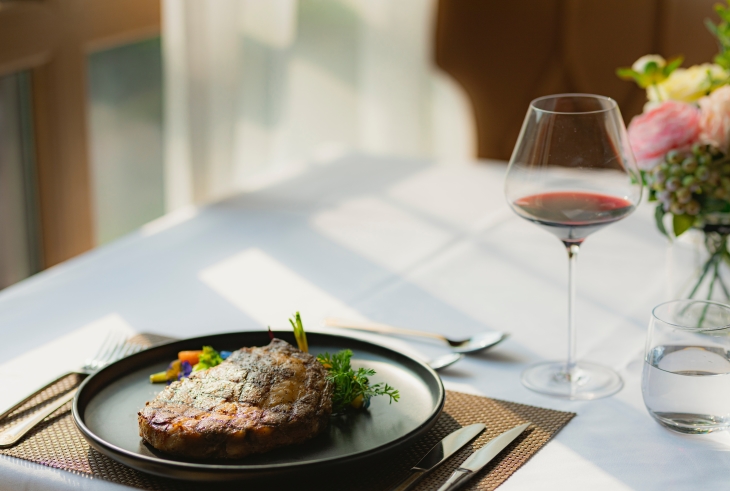Wine Pairing Tips For Beginners
Drinking a high-quality wine or food by themselves can be a great experience. But when you pair the right wine and food together, it can take your dining experience to the next level.
Discovering the ideal pairing can be challenging. It’s an art that requires knowledge and understanding of flavor profiles, textures, weight, and many other factors. For example, when you pair a light-bodied wine with intensely flavored food or vice versa, it can lead to one overpowering the other.
Essentially, you have congruent and contrasting pairings. Congruent pairings produce flavor profiles that either mirror or complement each other. On the other hand, contrasting pairings combine diverse flavors that ultimately work well together.
That’s just the gist of wine pairing. Below, Vint explains the basics of wine pairing so that you can get the most from your dining experience.
How to Pair the Right Wines and Foods
Even if you are just a casual wine drinker, you might be amazed by what a nice glass of wine and a well-paired meal can do for your tastebuds. You’ve heard plenty of people talk about it, but how do you find suitable matches for such an experience?
While food and wine pairing can become very nuanced, with sommeliers and chefs working to match the acid, sugar, alcohol, and structure of a wine with the elements in the dish. However we won’t dive into that here, for the purposes of this introduction, here are a few general tips that can help you create a wonderful pairing experience as a beginner:
Start with the Wine
If you are just learning how to pair wines and food, you can always start with a wine you like. If you are not crazy about red wines, start with trying to pair white wines with your meals..That said, one of the beauties of wine pairing is that the food and wine work together, often changing the perception of each (for the better if properly paired). So, be aware, your favorite wine may taste a little different when consumed with food..
That said, it is always good to broaden your wine repertoire and going to wine tastings and sampling different varieties may expand your palate and allow you to discover new wines you never knew you would love.
Strike a Balance
Anytime you pair wine and food, the ultimate goal is for them to balance each other out. You don’t want your wine overwhelming your food or vice versa. This doesn’t mean pairing opposites, just that you wish to equal flavors from your wine and food.
For example, if you have a rich red wine, it will probably go well with a hearty steak or meat dish. On the other hand, sauteed fish tends to pair well with a light-bodied white wine because of the inherent qualities of both.
Again, this is only an introduction to balance. When you are balancing flavor, you are really utilizing the tools of acid, alcohol, tannis, and sugar and don’t even know it!
Also keep in mind, while complementary pairings are great, opposite flavors can also pair for a tremendous experience.
Focus on the Main Flavor
You should always match your wine to whatever meal component is the most prominent. Sometimes, this is the main ingredient, while other times, it's the sauce or seasonings.
Anytime mushrooms are an element, it tends to create an earthy, rich flavor, meaning it would need to be paired with red wine or white wine with similar qualities. That said, a recipe with a creamy lemon sauce may pair best with white wine with lemon tones and bright freshness.
As such, most wine connoisseurs suggest pairing a wine to the sauce of a dish rather than the unerlying elements.
Pairing Methods for Wine and Food
One approach to wine and food pairings is to think of pairing in two categories: congruent and contrasting pairings. Let's discuss each one in more detail.
Congruent Pairings
When the food and wine in a pairing share several flavors, aromas, and textures, it can be considered a congruent pairing. Common examples include pairing a glass of rich white wine (ex. oaked Chardonnay) with a buttery aftertaste with a buttery chicken pasta. Another example would be pairing a sweet wine with a dessert pastry (just make sure the wine is sweeter than the pastry, otherwise it will it will taste dry and almost bitter).
When creating a congruent pairing, the flavors of the food mustn’t overwhelm those of the wine. Otherwise, you will miss out on nuances in the wine and it will taste insipid.
The ultimate goal of pairing is for the wine and the food to enhance the flavors of one another. Most congruent pairings work best with white wines. White wines come in many different styles and offer a wide range of tastes and aromas, that are incredibly diverse, can match with many types of food from seafood to chicken in cream sauce.
Contrasting Pairings
Contrasting pairings (A.K.A. complementary pairings) are when you match wine and food that do not share any flavors or textures. Instead, all the flavors are balanced out, and the contrasting characteristics off-set each other or work together to create new a flavor experience.
People often use white, rose, and sparkling wine for contrasting pairings. For example, if you pair an off-dry white wine with a spicy dish, it will level out the dish’s heat.
People also pair white wine with fatty or fried dishes. This is because the freshness and fruit in the white wines balances the weight of fried foods by cutting through the fat and refreshing the palate. Wines made from Chardonnay and Pinot Grigio both offer both acid forward and fruity expressions that can pair with everything from salty popcorn to fried chicken or fish dishes..
Pairing By the Wine
Because red wine, white wine, and sparkling wine offer many diverse and complex flavors, there are enumerable possibilities when pairing different wines with different foods.
A bold red wine may work with many meat entrees, while a dry white wine could bring new flavors to various fish.
Below, we’ve broken down some of the most common red and white wine and given practical tips for creating pairings.
Red Wine
While there are other red varieties to consider, let’s discuss three distinct varieties used for pairing:
Cabernet Sauvignon Cabernet Sauvignon is known for its high tannins, blackberry, blackcurrant, and plum flavors. A full-bodied Cabernet Sauvignon offers a bright and bold fruity taste that matures over time.
Because the tannins are so strong in this type of wine, it does a great job of resetting your palate with each bite, making it the ideal wine for steak, lambchops, and similar meats.
Pinot Noir Unlike Cabernet Sauvignon, Pinot Noir typically comes with a lighter body with earthy flavors. Warm spices, cherries, plums, dark berries, and violets are familiar flavors in a Pinot Noir.
This variety contains minimal tannins, making it ideal for fatty fish like tuna and salmon. It also pairs well with pork chops, lamb, and venison.
Syrah If you enjoy spicy dishes, you can take your dining experience to the next level by pairing them with Syrah. This red variety provides a spicy flavor profile on its own and perfectly matches grilled meats, pork barbecue, and lamb.
However, you must be careful as you pair Syrah wines with spicy foods; be conscious of both the wine’s alcohol and food’s spice level. If the alcohol is too high, it will only be amplified by the spice and by the same token if the food’s is too powerful you won’t taste the nuances in the wine..
Rosé Wine
Dry Rosé Rose plays the middle ground between red and white wine, and because of that, it offers some of the most diverse pairings. Dry rose tends to be fruity and acidic, making it an ideal match for pretty much any type of cheese.
It also provides very little bitterness and a refreshing taste, often with hints of citrus, cherries, strawberries, and herbs. Dry rose makes for a great pairing with spicy seafood and grilled chicken.
White Wine
Now, let’s take a look at some potential pairings with some of the most common white wines in the world:
Chardonnay Chardonnay is one of the most popular styles of wine worldwide, and it can provide many different tastes and aromas, depending on the brand and region. That said, this type of wine usually offers plenty of tree fruit flavors (e.g., pear, green apple) and in warm conditions tropical notes (pineapple, melon, etc.); all these fruity flavors are typically balanced with vanilla from use of oak.
This makeup leaves Chardonnay to pair well with vegetables, grilled lobster, shellfish, tilapia, and any dish with a rich sauce. Chardonnay often comes in a range of styles from lean and bright to rich and creamy, all depending on where it is grown and the winemakers decision on style.
Sauvignon Blanc On the other hand, Sauvignon Blanc is usually high in acidity and light-bodied. This white variety provides a crisp taste and pairs perfectly with cheese, delicate fish, oysters, fresh herbs, and tart sauces.
As you can see, wines and foods that are both high in acidity tend to work well together. Rather than competing with each other, the food's and wine's acidity combine to bring out more natural flavors.
Pinot Grigio If you are a fan of light seafood, Pinot Grigio is the best option for your pairing. It offers a crisp and delicate taste, enhancing the dish's flavors. You will notice Pinot Grigio often presents hints of sweet spice, lemons, pears, and melons.
Remember to be conscious that the food and wine do not overpower each other with any pairing. This is critical when matching a delicate wine with a light fish. If the flavor profile is stronger than the other, it can significantly reduce the flavor of the wine.
Other foods to consider matching to Pinot Grigio include grilled chicken, pasta, and foods with fresh herbs.
Off-Dry Riesling Rieslings can be found in a range of styles, today we are going to discuss the off-dry style, made famous initially in the Mosel Valley in Germany. Most off-dry Riesling offers lime, green apple, apricot, and white peach hints. Overall, it's a delicate and lightly sweet white wine that matches well with spicy dishes. Among other reasons, the semi-sweet flavor of this white variety tends to tame the fire in spicy foods.
You can also match pork (ham, pork chops, etc.), thai food,, shellfish, and salads to off-dry Riesling. It's a great option for salads with vinaigrettes because it has no tannins or bitterness and has acid and light sweetness that will pair well. Conversely, if you pair wine with little acidity and tannins with a bitter vinaigrette, it will only make the wine and food taste more bitter.
Food Flavor Profiles to Consider
When you're learning to pair wine and food, it can also help to place each into one of several flavor profiles. The six primary profiles include acid, fat, bitter, salty, sweet, and spicy. Let's break down each flavor profile and discuss this approach to find suitable matches for your wines and dishes.
Acid Many wines and foods contain acid, meaning you can use them for congruent and contrasting pairings. In particular, acid helps wine and food taste fresher. It's imperative, however, that a wine's acidity at least equals that of the food's; otherwise, you will end up with a bland-tasting wine.
Therefore, most people pair wines with a higher acidity than the dish. Be especially conscious of salad dressings because they tend to be very acidic. Rather than basing your match on the salad itself, base it on the dressing. A great wine for salads with acidic dressings is Sauvignon Blanc.
Protein / Fat There is no fat in wine, so only contrasting pairings are possible for fatty foods. Tannins are critical when matching a protein-heavy dish because the tannins bond with the proteins to help break down the meat and inturn can enhancing the meat's flavor profile and as well as the wine’s.
For fatty foods (like fried chicken), stick to high-acid wines like sparkling wines or a crisp light white, this is because the wine's acid cuts through the fat and cleanses your palate before the next bite.
Bitter As a general rule of thumb, do not pair bitter wine with bitter food because it will only enhance the bitterness of both. In other words, stick to contrasting pairings. If you have a bitter wine, match it with a dish with minimal bitterness and vice versa. Bitter foods pair well with off-dry expressions of Riesling, Zinfandels, and fruit-forward wines.
Salty The salt in a dish can significantly impact the overall flavor profile. Shellfish, potatoes, fried foods, and many other foods contain salt. Acidic wines and sparkling wines tend to make for the best matches for salty foods.
For example, acidic wines can level out the flavors within a dish, making for an excellent contrasting pairing.
Sweet If you are trying to match a dessert or another type of sweet food, it's vital to consider the level of sweetness in the wine. It will render the wine tasteless if it does not taste sweeter than the dessert. Sweet dishes also tend to amplify a wine's bitterness, which will result in an unpleasant taste. Therefore, don't pair any high-tannin varieties with sweet foods.
Spicy Though they are typically quite complex, spicy foods are excellent for congruent and contrasting pairings. When making a pairing, you want the spicy food to enhance the bitterness and acidity in wine while decreasing its sweetness and weight. For example, Riesling can make for an excellent contrasting match because of its potent fruit flavors and sweetness.
9 Tried-and-True Wine Pairings
Now that you understand some of the philosophy that goes behind matching wines and foods, let's touch on some specific wine pairings that have proven delectable over time:
1. Cabernet Sauvignon with Red Meat Because of Cabernet Sauvignon's rich, robust tannins and rich fruit flavors, it pairs perfectly with burgers, steak, venison, and lamb. A good Cabernet Sauvignon and grilled ribeye are hard to beat.
2. Chianti with Tomato Sauces Pair Chianti with any dish with tomato sauce and fresh herbs, and you will have a match made in heaven. Both Chianti wines and tomato sauces have a high acid content, making them ideal for one another.
3. Pinot Noir with Earthy Dishes Pinot Noir is one of the most earthy wines globally, and it comes with hints of fruit and berry. That's why it works so well with an earthy food like herb-crusted lamb or mushroom beef stew. This red variety even tastes good with fish like tuna or grilled salmon.
4. Malbec with Any Meat Malbec pairs amazingly with meat. The fruity profile perhaps works best with barbecue ribs and other sauce-heavy meat dishes.
5. Merlot with Roasted Meat Merlot is well-loved because of its vibrant red fruit flavors and plush texture. This red variety will blow your mind when paired with roasted duck, pork, or chicken. It's the best wine to have at Thanksgiving dinner.
6. Riesling with Sushi, Chicken, or Pork Riesling offers a wide range of pairings because it is versatile. Take a dry Riesling and match it to anything from chicken to pork to sushi, and pair an off-dry variety to a spicy dish.
7. Pinot Grigio with Light Pastas or Seafood Pinot Grigio is one of the easiest wines to drink, and its citrusy profile matches well with pasta primavera and zesty seafood dishes. It also makes the perfect match for fish tacos, fried calamari, or a light salad.
8. Sauvignon Blanc with Seafood or Vegetables Sauvignon Blanc goes perfectly with seafood, vegetables, and other lighter entrees. Its citrusy and grassy flavors and aromas make it an excellent companion to brunch foods and vegetable stir-fry.
9. Chardonnay with Oysters or Crab Cakes Most Chardonnays are produced either oaked or unoaked. Full-bodied oaked Chardonnays pair perfectly with butternut squash ravioli, hearty fish in a creamy sauce, and other rich entrees. Pair your light-bodied, highly acidic Chardonnays with oysters or crabcakes.
##"Wining" Down If you never tried to pair your wine with your meal, you are only scratching the surface of your wine drinking experience. Consider the information and advice above as you learn the ins and outs of pairing the right wines with the right foods.
As you learn more about wines, you may benefit from getting into wine investing. A platform like Vint makes wine investing easy for you, even if you have minimal experience. Reach out today to connect with one of our experts and begin diversifying your portfolio.
Sources: The 14 Best Cabernet Sauvignons to Drink in 2022 | Liquor.com
The Best White Wines to Buy in 2022 | Travel + Leisure
17 Rieslings That Show Off Everything the Grape Can Do | Food & Wine


